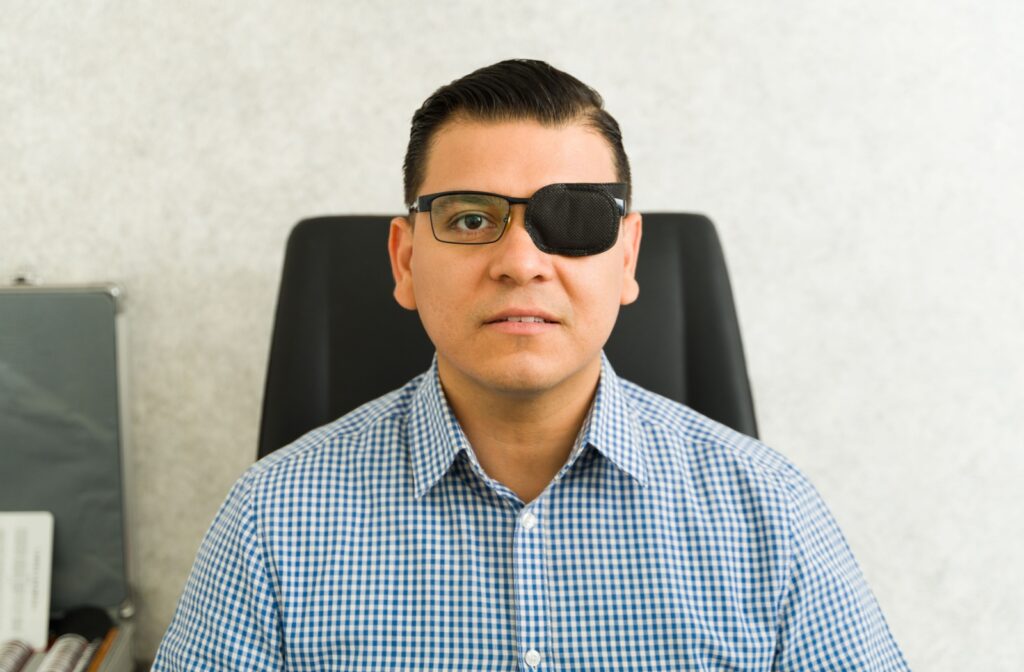Lazy eye, also known as amblyopia, is commonly considered a childhood issue, but adults can develop it as well. The most common cause of amblyopia in adults is a childhood onset that was never treated or resolved. This means the person had amblyopia as a child, but it either wasn’t diagnosed or properly treated.
As they grew older, their visual system adapted to compensate for the weaker eye, resulting in a permanent reduction in vision. Other possible causes include uncorrected refractive errors, eye surgery, or trauma to the eye.
What Is Lazy Eye?
Amblyopia is when one eye has reduced vision because it hasn’t visually developed properly. The brain starts favoring the stronger eye, which weakens the connection between the brain and the “lazy” eye.
This eye imbalance can create depth perception, focus or attention issues, but it often develops with few symptoms because the other eye compensates for the vision changes. While it’s most commonly diagnosed in children, adults can also suffer from amblyopia.
Because amblyopia doesn’t always come with obvious symptoms, some people don’t even realize they have it until adulthood.
What Causes Lazy Eye?
A variety of factors can cause amblyopia.
Uncorrected Refractive Errors
Imagine one eye needing a glasses prescription (blurry for far or near objects) while the other is perfectly normal. When these vision imbalances go uncorrected for long periods, your brain may “choose” the stronger eye and ignore the weaker one. Over time, this could lead to amblyopia.
Muscle Imbalance
Sometimes, adults develop strabismus, a muscle imbalance where your eyes don’t align correctly. This causes one eye to turn inward, outward, upward, or downward, preventing them from working together. Eventually, the stronger eye does most of the visual work, weakening the other.
Structural Abnormalities
Conditions such as cataracts or droopy eyelids can block clear vision in one eye. If left untreated, this “blocked” eye can’t help the stronger eye with vision, leading to strain and vision difficulties.
Trauma or Injury
Accidents that cause severe damage to the eye or optical nerve can disrupt vision and lead to amblyopia. Traumatic incidents can impair how the weaker eye communicates with the brain.
Neurological Issues
Some rare cases of amblyopia may stem from problems in the brain’s visual pathways rather than the eye itself. These require advanced diagnostic methods to uncover.
Signs & Symptoms of Lazy Eye in Adults
Spotting amblyopia isn’t always as straightforward as you’d think. Adults can experience subtle or more noticeable symptoms, including:
- Blurry vision in one eye
- Difficulty with depth perception
- Eyestrain or headaches after prolonged focus
- One eye “wandering” (strabismus)
- Double vision in more severe cases
If you’re experiencing any combination of these symptoms, it might be time to see your eye doctor.

How Is Lazy Eye Diagnosed?
Diagnosing amblyopia in adults often requires a detailed eye exam. Here’s what to expect when you visit an optometrist:
- Visual acuity test: This measures how sharp your vision is in each eye
- Alignment evaluation: Your doctor will check how well your eyes work together to focus on an object
- Refraction test: This determines if you have nearsightedness, farsightedness, or astigmatism in one or both eyes
- Eye health assessment: Structural issues, such as cataracts or droopy eyelids, can also be examined
These tests help narrow down the cause of your symptoms and create a plan of action.
Treatment Options for Adult Lazy Eye
Depending on the root cause, there are several effective treatments.
Vision Therapy
Vision therapy involves exercises and activities designed to improve the connection between your brain and your weaker eye. Think of it as a workout for your eyes. Techniques include balance boards, virtual-reality-style games, and more. These strategies are effective for children and teens.
Corrective Lenses
Prescription eyeglasses or contact lenses correct refractive errors, helping your weaker eye focus better. Some lenses even include prisms to address alignment issues. This treatment is most common for adults.
Eye Patching
Though patching is more common for children, there are some cases where it can still work for adults. Covering the stronger eye forces the weaker eye to work harder, gradually improving its ability to focus.
Surgery
If your amblyopia stems from strabismus or a structural issue (like cataracts), surgery might be needed to align your muscles or remove obstructions. For best results, it’s often followed up with other therapies.
Tips for Preventing Eye Strain & Promoting Eye Health
Prevention might not treat amblyopia directly, but these habits can help build healthier vision and avoid other complications:
- Take breaks during screen time (consider the 20-20-20 rule)
- Make sure your prescription for glasses or contacts is up to date
- Schedule regular eye exams, especially if you notice signs of vision changes
- Maintain a balanced diet rich in vitamin A, omega-3 fatty acids, and antioxidants to support eye health
- Wear sunglasses outdoors to protect your eyes from harmful UV rays
Take Control of Your Vision Today
Amblyopia in adulthood might seem daunting, but understanding the causes, symptoms, and available treatments is the first step toward better vision. Whether it’s therapy, surgery, or simply wearing corrective lenses, plenty of options are available.
Catching and treating the condition can dramatically improve your vision. If you’ve been experiencing symptoms of amblyopia or are overdue for an eye exam, call our expert team at Discover Eyecare today and book an appointment. Your vision deserves the best care, no matter your age.



